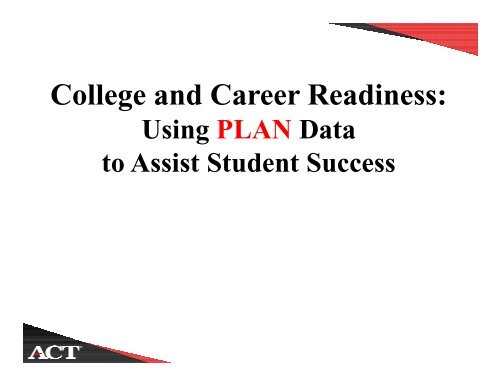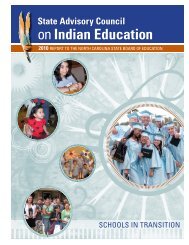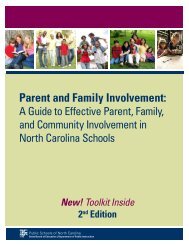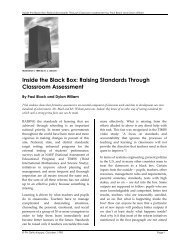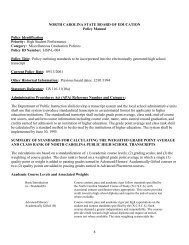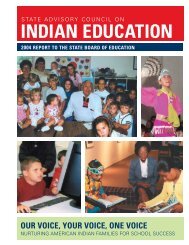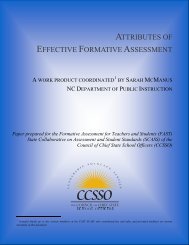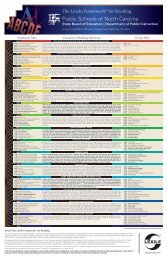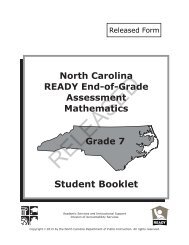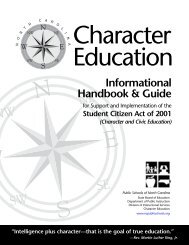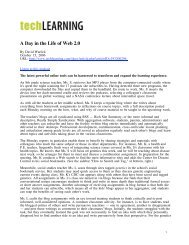pdf, 9.7mb - Public Schools of North Carolina
pdf, 9.7mb - Public Schools of North Carolina
pdf, 9.7mb - Public Schools of North Carolina
You also want an ePaper? Increase the reach of your titles
YUMPU automatically turns print PDFs into web optimized ePapers that Google loves.
College and Career Readiness:<br />
Using PLAN Data<br />
to Assist Student Success
What makes ACT unique?<br />
Not-for-pr<strong>of</strong>it<br />
Reinvestment<br />
Education and the Workforce<br />
50+ years worth <strong>of</strong> functional data<br />
Research agenda<br />
Customer service
What is Our Research Telling Us?<br />
http://www.act.org/research/
Affirming the Goal<br />
Research Report that confirms:<br />
ACT’s College Readiness Standards<br />
and the new Common Core State<br />
Standards are competitive world<br />
wide. wde.<br />
These standards are high and<br />
challenging standards on their own.<br />
http://www.act.org/research/policymakers/<strong>pdf</strong>/AffirmingtheGoal.<strong>pdf</strong>
Alignment with the Common Core<br />
Describes the strong alignment between ACT’s College Readiness<br />
Standards and the new Common Core State Standards.<br />
www.act.org/commoncore
Every student should be<br />
prepared to a standard <strong>of</strong><br />
readiness for postsecondary<br />
education and work
College and Career Readiness Defined<br />
ACT defines college and career readiness as the acquisition <strong>of</strong> the<br />
knowledge and skills a student needs to enroll and succeed in creditbearing,<br />
first-year courses at a postsecondary institution (such as a twoor<br />
four-year college, trade school, or technical school) without the need<br />
for remediation.<br />
ACT’s definition <strong>of</strong> college and career readiness was adopted by the<br />
Common Core State Standards Initiative and provides a unifying goal<br />
upon which educators and policymakers must now act.
Guiding Principles<br />
• The tests are achievement tests. They are tests <strong>of</strong> acquired or<br />
developed abilities.<br />
• The tasks (questions) constituting all tests correspond to<br />
recognized middle and high school learning experiences.<br />
• The tests consists <strong>of</strong> complex, heterogeneous tasks that require<br />
students to use skills and knowledge developed over time to solve<br />
them.<br />
• Each test is developmentally appropriate for the grade level.
College and Career<br />
Readiness System<br />
SCIENCE<br />
READING<br />
MATHEMATICS<br />
ENGLISH
Score Scales Relationship<br />
40<br />
35 32<br />
30<br />
25 25<br />
20 English<br />
15 Math<br />
10 Reading<br />
5<br />
Science<br />
0<br />
English<br />
Math<br />
Reading<br />
Science<br />
36<br />
English<br />
Math<br />
Reading<br />
Science<br />
Writing<br />
EXPLORE<br />
PLAN<br />
ACT<br />
8 th /9 th Grade<br />
10 th grade<br />
11 th /12 th grade
• Content Development<br />
– State objectives<br />
– State approved texts<br />
– National pr<strong>of</strong>essional organizations<br />
– Surveys (middle to postsecondary)<br />
• Item Writers<br />
• Fairness Consulting
College Readiness Standards<br />
Help interpret what the scores earned in<br />
EXPLORE ® , PLAN ® and the ACT ® mean<br />
Identify the knowledge and skills students are<br />
likely to demonstrate at various score levels on<br />
each academic test<br />
Serve as a direct link between what students<br />
have learned and what they are ready to learn<br />
next
The PLAN Interpretive Guide is<br />
designed to help you understand<br />
and effectively use the:<br />
Student Score Reports<br />
Student Score Labels<br />
Student List Report<br />
Pr<strong>of</strong>ile Summary Report<br />
Presentation Packet<br />
Early Intervention Rosters<br />
How the College Readiness<br />
Standards & Benchmarks<br />
should be Interpreted and Used<br />
www.act.org/plan/<strong>pdf</strong>/PlanInterpGuide.<strong>pdf</strong>
ACT’s College<br />
Readiness Standards<br />
Example:<br />
Mathematics<br />
College Readiness Standards
Curriculum Review Worksheet<br />
TABLE 1 (continued): English College Readiness Standards for Score Range 16–19<br />
English Standards<br />
For each skill, knowledge, or process:<br />
Is it included in your<br />
English<br />
curriculum?<br />
At what grade level (or in which course) are<br />
students first introduced to it?<br />
At what grade level (or in which course) are<br />
students expected to demonstrate<br />
pr<strong>of</strong>iciency?<br />
Identify the basic purpose or role <strong>of</strong> a specified phrase or sentence<br />
Delete a clause or sentence because it is obviously irrelevant to<br />
the essay<br />
Select the most logical place to add a sentence in a paragraph<br />
Delete obviously synonymous and wordy material in a sentence<br />
Revise expressions that deviate from the style <strong>of</strong> an essay<br />
Determine the need for punctuation and conjunctions to avoid<br />
awkward-sounding sentence fragments and fused<br />
sentences<br />
Decide the appropriate verb tense and voice by considering i the<br />
meaning <strong>of</strong> the entire sentence<br />
Solve such grammatical problems as whether to use an adverb or<br />
adjective form, how to ensure straightforward subject-verb<br />
and pronoun-antecedent agreement, and which preposition<br />
to use in simple contexts<br />
www.act.org/standard/instruct/<strong>pdf</strong>/CurriculumReviewWorksheets.<strong>pdf</strong>
College Readiness Benchmark<br />
Scores Explained<br />
Research-based<br />
Real students’ grades in freshman-level<br />
college courses, from colleges around US,<br />
compared to ACT scores<br />
These benchmarks represent the median<br />
(50% above/50% below)<br />
Represent “typical” students at” “typical”<br />
colleges<br />
www.act.org/readiness/
*Th ACT B h k S i di t 50% h f<br />
*The ACT Benchmark Score indicates a 50% chance <strong>of</strong><br />
obtaining a “B” or a 75% chance <strong>of</strong> obtaining a “C” in<br />
corresponding credit-bearing college courses.
Students who meet ACT’s College<br />
Readiness Benchmarks are:<br />
substantially more likely to enroll in college<br />
less likely to need remediation<br />
more likely to achieve a grade <strong>of</strong> B or higher in specific college<br />
courses<br />
More likely to re-enroll at the same postsecondary institution their<br />
second year<br />
More likely l to persist to degree completion
<strong>North</strong> <strong>Carolina</strong>’s<br />
College and Career Readiness System<br />
Longitudinal Assessments<br />
Career/CTE<br />
+ Writing<br />
8th–9th Grade<br />
Score Scale: 1—25<br />
10th Grade<br />
Score Scale: 1—32<br />
11th Grade<br />
Score Scale: 1—36<br />
12th Grade<br />
Career Readiness Gauge<br />
English, math, reading, science, optional Writing Test<br />
(ACT only)<br />
Career and Educational Components<br />
Students completing<br />
a CTE sequence<br />
The College Readiness System is a comprehensive program intended to<br />
help states implement the policy actions necessary to help pprepare<br />
p<br />
every student for college and work. The system is a fully aligned,<br />
research-based solution.
WorkKeys<br />
® is a job skills assessment system<br />
that helps employers select, hire, train, develop,<br />
and retain a high-performance workforce.<br />
• All testing in February 2012<br />
• CTE Concentrators<br />
• Internet or Paper Assessments<br />
• Approximately 40,000 students<br />
• Eligible students will receive the NC CRC (Career Readiness<br />
Certificate)
College and Workforce Ready<br />
National research provides empirical evidence that the<br />
levels <strong>of</strong> readiness that high school graduates need to be<br />
prepared for college and workforce training are<br />
comparable.<br />
All students, therefore, should “experience a common<br />
academic program….regardless regardless <strong>of</strong> their post-graduation<br />
plans.”<br />
College-Ready and Work-Ready: Same or Different?<br />
ACT 2006<br />
www.act.org/research/policymakers/<strong>pdf</strong>/ReadinessBrief.<strong>pdf</strong><br />
/ / i i f f
<strong>North</strong> <strong>Carolina</strong>’s<br />
Accountability Assessments<br />
+ Writing<br />
11th Grade<br />
Score Scale: 1—36<br />
&<br />
12th Grade<br />
Career Readiness Gauge<br />
English, Math, Reading, Science,<br />
Writing<br />
Career and Educational Components<br />
Reading for Information,<br />
Applied Mathematics,<br />
Locating Information
NC Legislation…<br />
i<br />
SB 479 and HB 766 call for a series <strong>of</strong><br />
nationally and internationally<br />
benchmarked tests with a history <strong>of</strong><br />
successfully predicting college success<br />
to measure college readiness and<br />
progress towards these readiness targets<br />
t<br />
in the secondary schools.
Post‐Secondary Readiness<br />
Recommendation<br />
Administer ACT and WorkKeys to<br />
all students as part <strong>of</strong> the new<br />
Accountability<br />
Model.<br />
Rationale<br />
•Set the same standard for all students<br />
•Give all students options post‐graduation<br />
•Results are usable and transportable<br />
•Avoid possibility <strong>of</strong> “tracking” students
• Curriculum-based achievement test that measures college<br />
readiness<br />
• Scores tied to empirically-derived College Readiness Standards<br />
• Provides a midpoint assessment <strong>of</strong> academic progress toward<br />
college and career readiness when used with EXPLORE and the<br />
ACT<br />
• Most powerful predictor <strong>of</strong> performance on the ACT<br />
• Used for course placement including dual-enrollment/rigorous<br />
courses<br />
• Career Interest Inventory and educational/career plans collected
What <strong>Schools</strong> Need to Know to Help<br />
Students’ Skills/Scores Improve<br />
• What skills the test measures<br />
• How the test measures the skills<br />
• How the test relates to curriculum<br />
• What skills students already know<br />
• What skills students need to learn<br />
• What instructional ti methods would be most effective<br />
in meeting the students’ needs<br />
. . .
PLAN Content<br />
PLAN Part 1<br />
Non Cognitive (45-60 minutes)<br />
• Student Information<br />
• Plans and Background<br />
• Needs Assessment<br />
• Supplemental Local Items<br />
• UNIACT Interest Inventory<br />
• 72 Questions<br />
• Typically completed on a<br />
separate day yprior to the<br />
academic test.
PLAN Content<br />
PLAN Part 2<br />
Academic Sections (120 minutes)<br />
• English 50 Items (30 minutes)<br />
• Math 40 Items (40 minutes)<br />
– Calculators Allowed (page 9) on Math only<br />
• Break (5 minutes)<br />
• Reading 25 Items (20 minutes)<br />
• Science 30 Items (25 minutes)<br />
Students Must Complete All Sections
English Test<br />
Designed to measure students’ ability to effectively<br />
communicate meaning by:<br />
Critiquing<br />
Revising<br />
Editing
Mathematics Test<br />
Requires Students to:<br />
Analyze problems – in both real world and purely<br />
mathematical settings<br />
Plan and carry out strategies<br />
Achieve an integrated understanding <strong>of</strong> two or more major<br />
concepts so as to solve non-routine problems
Reading Test<br />
Measures student pr<strong>of</strong>iciencies in understanding and deriving<br />
meaning from texts ranging from fiction narratives to<br />
informational passages<br />
Measures vocabulary by determining the meaning <strong>of</strong><br />
unfamiliar a or multiple-meaning utpe ea words from context<br />
t<br />
Measures skills used to read and understand published<br />
materials
Science Test<br />
Measures student pr<strong>of</strong>iciencies in using and<br />
reasoning with science information, skills, and<br />
knowledge<br />
Ak Asks Students to:<br />
Communicate information and use scientific research<br />
strategies<br />
Make comparisons between, and draw conclusions<br />
from scientific findings, studies, and viewpoints
Science Test<br />
Content Area<br />
1<br />
Format<br />
Earth/Space<br />
Science<br />
Biology<br />
Chemistry<br />
Physics<br />
Data Representation<br />
Research hSummaries<br />
Conflicting Viewpoints<br />
1 Content areas are distributed over all formats
Focus on the PLAN Program:<br />
The PLAN Test and non-cognitive components<br />
School Reports Package: District Reports Package:<br />
-Student Reports (2)<br />
-Student Score Labels (2)<br />
-Pr<strong>of</strong>ile Summary Report<br />
-Pr<strong>of</strong>ile Summary Report<br />
-Presentation Packet<br />
-Presentation Packet<br />
-Intervention Rosters<br />
-Item Response Summary Report<br />
-Item Response Summary Report<br />
-Research Data File<br />
-Research Data File<br />
Planning Distribution/interpretation <strong>of</strong> reports<br />
Sharing Data with teachers and administrators
www.act.org/plan/<strong>pdf</strong>/UsingPLANResults.<strong>pdf</strong><br />
www.act.org/plan/<strong>pdf</strong>/UsingPlanResultsSP.<strong>pdf</strong>
http://www.act.org/plan/downloads.html
Student Score Report<br />
Scores<br />
Course Plans<br />
College Readiness<br />
Benchmarks<br />
College/Career Plans<br />
Needs Assessment<br />
Career Interest<br />
Inventory<br />
Item Analysis
Student/School Information
What do Your Scores Mean?<br />
Composite Score 18<br />
Range<br />
(1-32)<br />
Please<br />
Note:<br />
State<br />
Norms are<br />
Not<br />
Currently<br />
Available<br />
in NC;<br />
this<br />
column<br />
will be<br />
blank.
Estimated ACT Composite Score Range
What is a Good ACT Score?<br />
Depends on:<br />
1. Where you want to go to school<br />
2. How much scholarship hi money you need<br />
3. NCAA Requirements<br />
• National Composite Average = 21.1<br />
• <strong>North</strong> <strong>Carolina</strong> Composite Average = 21.9
A few <strong>North</strong> <strong>Carolina</strong> examples:<br />
Middle 50% <strong>of</strong> 2011 freshman classes:<br />
NC State Raleigh 23-28<br />
UNC Chapel Hill 27-31<br />
East <strong>Carolina</strong> University 20-24<br />
24<br />
Appalachian State 21-26<br />
UNC Wilmington 22-26<br />
Source: ACT College Search and for iPhone ® and iPod ® touch<br />
http://www.act.org/mobileapps/
www.act.org/plan/<strong>pdf</strong>/HelpStudentsUsePLAN.<strong>pdf</strong>
Use PLAN to Predict Student Success on<br />
AP Exams
NC College Readiness Benchmarks on PLAN:<br />
PLAN<br />
English 15<br />
Reading 17<br />
Mathematics 19<br />
www.careercollegenc.org/pathways-collegetransfer.htm
College Readiness
High School Course Plans Compared to Core
Pr<strong>of</strong>ile for Success
EOS – Improving Student Access to<br />
Postsecondary Education<br />
• Students opt in to EOS by agreeing to the EOS<br />
release statement on PLAN and the ACT<br />
• Colleges obtain student names, based on their<br />
selection criteria from, so they may contact<br />
students about educational and scholarship<br />
opportunities<br />
• ACT does NOT provide student SSNs as part <strong>of</strong><br />
the EOS record
EOS Conditions <strong>of</strong> Use<br />
Access to The ACT® and PLAN® names is<br />
restricted to accredited, postsecondary educational<br />
institutions and scholarship agencies that <strong>of</strong>fer<br />
programs <strong>of</strong> study at the secondary or<br />
postsecondary level, educational enrichment<br />
programs, or financial aid for Postsecondary study
Students’ Reported Needs<br />
Making plans for my education, career, and work after high school<br />
Improving my writing skills<br />
Improving my reading speed and comprehension<br />
Improving my study skills<br />
Improving my mathematical skills<br />
Improving my computer skills<br />
Improving my public speaking skills
Included in all CCRS tests at no extra charge<br />
72 item unisex interest inventory <strong>of</strong> work relevant activities<br />
Identifies personally relevant career options<br />
Bridged to World-Of Work Map and Holland Types
World-<strong>of</strong>-Work <strong>of</strong> Work Map Tutorial:<br />
http://www.act.org/wwm/about.html
Information for Counselors<br />
Based on John Holland’s theory <strong>of</strong> careers<br />
Provides Holland Code/Career Cluster Scores:<br />
R = Realistic (Technical)<br />
I = Investigative (Science & Technology)<br />
A = Artistic (Arts)<br />
S = Social (Social Service)<br />
E = Enterprising (Administration & Sales)<br />
C = Conventional (Business Operations)<br />
% <strong>of</strong> Like, Indifferent, and Dislike Responses
PLAN Score<br />
Report<br />
- Side 2
Review Your Answers
Your Skills
www.planstudent.org
Aggregate g Reports<br />
Student List Report<br />
School Summary Pr<strong>of</strong>ile Report<br />
Presentation Packet<br />
Early Intervention Roster<br />
Item-Response Summary Report<br />
<strong>Schools</strong> Receive a Paper Copy <strong>of</strong><br />
<strong>Schools</strong> Receive a Paper Copy <strong>of</strong><br />
each <strong>of</strong> the above Reports
Student List Report
Pr<strong>of</strong>ile Summary Report
Pr<strong>of</strong>ile Summary Report<br />
Provides an overall summary <strong>of</strong> information on students who<br />
have taken the test in the district/school<br />
Includes students who have a valid composite score and those<br />
who tested under standard time limits<br />
Organized to assist in addressing certain issues that are common<br />
among schools<br />
Includes option for 12 local items
Pr<strong>of</strong>ile Summary Report:<br />
Subjects & Composite Scores Page 2
Pr<strong>of</strong>ile Summary Report: Subscores Page 3
Pr<strong>of</strong>ile Summary Report:<br />
College Readiness Standards Tables Page 4
Pr<strong>of</strong>ile Summary Report:<br />
Ethnic & Gender Tables Page 5
Course Taking Patterns: Page 6
Coursework Relationship to<br />
Educational Plans: Page 7
PLAN Composite and<br />
Expressed Needs for Help: Page 7
Career Preferences: Page 8
Career Clusters from World <strong>of</strong> Work Map: Page 9
Response to Local Items: Page 10
Presentation Packet<br />
The Presentation Packet summarizes your school’ss<br />
PLAN results in charts and graphs for easy<br />
presentation to groups.<br />
Includes charts with data from Pr<strong>of</strong>ile Summary Report<br />
Will include three-year trends in your school’s average<br />
PLAN scores once your school has three years <strong>of</strong> data<br />
available
Norm Group Comparison<br />
Subject and Composite Scores: Page 1
Norm Group Comparison<br />
Subscores: Page 1
Early Intervention Rosters<br />
The Early Intervention Rosters identify students<br />
who qualify under three categories:<br />
Early Identification<br />
Coursework Intervention<br />
Need for Assistance<br />
This information can help you to design intervention<br />
strategies to assist students to reach their academic and<br />
career goals.
Early Identification Report
Coursework Intervention Report
Coursework Intervention Report
Need for Assistance Report
Item-Response Summary Report<br />
This report provides tables describing the item-by-item<br />
performance <strong>of</strong> your PLAN examinees.<br />
Item response results are categorized by:<br />
Test (e.g., English)<br />
Subscore (e.g., Usage/Mechanics)<br />
Content Area (e.g., Punctuation)<br />
Provide comparisons to other students taking the<br />
Provide comparisons to other students taking the<br />
same test form.
Item-Response Summary for English: Page 1
www.act.org/plan/<strong>pdf</strong>/ItemResponseSummaryGuide.<strong>pdf</strong>
www.act.org/plan/<strong>pdf</strong>/PlanInterpGuide.<strong>pdf</strong>
• Curriculum-based achievement test that measures<br />
college readiness<br />
• Administered in the 11 th or 12 th grade<br />
• Scores tied to empirically-derived College Readiness<br />
Standards<br />
• Accepted by all four-year colleges nationwide and many<br />
two-year colleges
From NC DPI…<br />
Weekly Message to Superintendents: Monday, Sept. 12, 2011<br />
As <strong>North</strong> <strong>Carolina</strong> moves toward a new school accountability<br />
model in 2012-13, the ACT will become a key high school<br />
measure for students and schools. Please mark your school<br />
district and high school calendars for March 6, 2012,<br />
planned as the first statewide ACT test administration date<br />
for high school juniors. More information about the ACT<br />
administration (training, ordering materials, accommodations,<br />
etc.), . . . will be coming in the future, but I wanted you to be<br />
able to mark this date on your calendars now. The cost <strong>of</strong> the<br />
ACT will be handled at the state level, so this college<br />
admission i test will be free <strong>of</strong> charge for individual id students.<br />
June Atkinson<br />
State Superintendent
What Scores are Reported?<br />
The ACT<br />
English (1-36)<br />
Mathematics (1-36)<br />
Reading (1-36)<br />
Science (1-36)<br />
Composite (1-36) An average<br />
The ACT Plus Writing<br />
Combined English and Writing Score (1-36)*<br />
Writing Test Subscore (2-12) *<br />
* Composite not affected
Use <strong>of</strong> ACT Scores<br />
HIGH SCHOOLS:<br />
Advising<br />
i<br />
Skills assessment<br />
College planning<br />
Eligibility --<br />
scholarships, programs<br />
Curricular review &<br />
enhancement<br />
COLLEGES:<br />
Recruiting<br />
Admissions<br />
Placement<br />
Advising<br />
Identification <strong>of</strong><br />
“at risk” students<br />
Scholarships<br />
Participation in sports
www.act.org/aap/hsreport.html
ACT – SAT Comparison<br />
Length<br />
Sections<br />
Subjects<br />
Reading Science<br />
ACT<br />
SAT<br />
3 hours, 25 minutes<br />
3 hours, 45 minutes<br />
(includes optional 30-minute Writing<br />
Test)<br />
4 Sections (plus optional Writing 10 Sections: 3 Critical Reading, 3<br />
Test): English, Math, Reading,<br />
Math, 3 Writing (including Essay), 1<br />
Science, Writing<br />
Experimental (not scored)<br />
English<br />
Critical Reading<br />
Math<br />
Math<br />
Reading<br />
Witi Writing<br />
Science<br />
Writing (optional)<br />
4 passages, 10 questions per passage Reading passages with questions<br />
pertaining to comprehension and<br />
sentence completion<br />
Science (analysis, knowledge, problem N/A<br />
solving)<br />
Math<br />
Arithmetic, algebra, geometry, and<br />
trigonometry<br />
Arithmetic, geometry, algebra, and<br />
algebra II
ACT – SAT Comparison<br />
ACT<br />
SAT<br />
Essay p ( ) q<br />
Essay Optional (final section) Required<br />
Score<br />
Composit<br />
ion<br />
Scoring<br />
¼ English<br />
1<br />
/ 3 Math<br />
¼ Math<br />
1<br />
/ 3 Reading<br />
¼ Reading<br />
1<br />
/ 3 Writing<br />
¼ Science<br />
Composite score 1-36 based on Aggregate score 600 - 2400 based<br />
average <strong>of</strong> 4 sections on total <strong>of</strong> 3 scores 200- 800<br />
(English Math, Reading Science) (Reading, Math, Writing)<br />
Score 0-12 for Optional Essay. Score <strong>of</strong> 0-12 for Essay<br />
Penalties<br />
No penalties for incorrect<br />
answers<br />
Penalties (typically ¼ point<br />
deducted) for wrong answers
Reading<br />
www.careercollegenc.org/pathways-collegetransfer.htm
Colleges currently accepting the ACT Test in lieu <strong>of</strong><br />
both the SAT Reasoning Test and SAT Subject Tests<br />
School State School State<br />
Amherst College<br />
Barnard College<br />
Boston College<br />
Boston University<br />
Brandeis University<br />
Brown University<br />
Bryn Mawr College<br />
Connecticut College<br />
Duke University<br />
MA<br />
NY<br />
MA<br />
MA<br />
MA<br />
RI<br />
PA<br />
CT<br />
NC<br />
Rensselaer Polytechnic Institute NY<br />
Swarthmore College<br />
PA<br />
Trinity College<br />
CT<br />
Tufts University<br />
University <strong>of</strong> Pennsylvania<br />
University <strong>of</strong> Richmond<br />
Vassar College<br />
Wellesley College<br />
Wesleyan University<br />
Johns Hopkins University Yale University<br />
MD<br />
McGill University Canada<br />
Middlebury College<br />
Pomona College<br />
VT<br />
CA<br />
MA<br />
PA<br />
VA<br />
NY<br />
MA<br />
CT<br />
CT
www.act.org/essayview/
ACT Resources
www.explorestudent.org<br />
www.planstudent.org<br />
www.actstudent.org
http://www.actstudent.org/testprep/index.html<br />
t t t /t t /i d
http://www.actstudent.org/qotd/<br />
t t t / td/
Resources for Educators<br />
Resources for Educators<br />
www.act.org/plan/downloads.html
PLAN Interpretive Visuals (PowerPoint)<br />
PLAN Interpretive Visuals (PowerPoint)<br />
http://act.org/plan/ppt/InterpVisual.pptx
www.act.org/stateservices/northcarolina/
http://act.org/aap/northcarolina/
<strong>North</strong> <strong>Carolina</strong><br />
ACT State Testing<br />
For more information on:<br />
ACT State Testing<br />
800/553-6244 x 2800<br />
ACT State Testing<br />
Accommodations 800/553-6244<br />
x 1788<br />
NCtest@act.org<br />
65
www.act.org/news/use/
www.act.org/path/parent/
www.act.org/path/parent/college/firstgeneration.html<br />
/ /fi i h l
Attend FREE ACT Webinars to increase the college and<br />
career readiness <strong>of</strong> your students<br />
Here's what you'll learn:<br />
Interpret the information in each part <strong>of</strong> the student score report<br />
Utilize ACT data reports to see if your students are on track for college and<br />
career readiness<br />
Quantify the progress your students are making<br />
Identify any gaps in skills and where to adjust curriculum to close the gaps<br />
Advise students and create student-specific interventions<br />
To learn more and register, go to<br />
www.act.org/learningevents.
www.act.org/standard
There’s an App for that!
…and this too!<br />
There’s an App for that…
= College and<br />
Career Readiness
Thank You!<br />
Southeast Region- Atlanta Office<br />
404-231-1952<br />
3355 Lenox Road NE, Suite 320<br />
www.act.org


